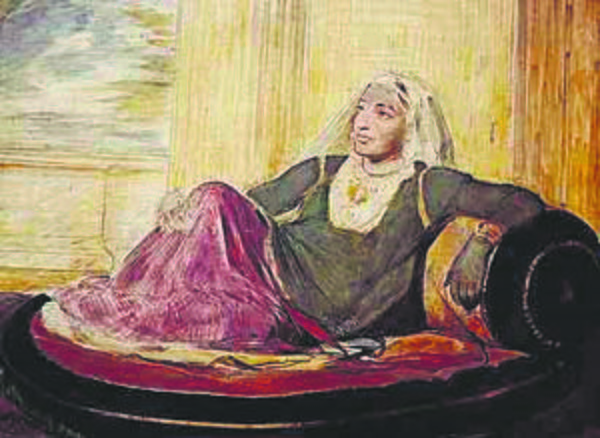
The Lioness of Punjab - Maharani Jind Kaur
Maharaja Ranjit
Singh, founder of the Sikh empire, whose boundaries stretched from Kabul to
Kashmir and the borders of Delhi, ruled undivided Punjab and northwest region
of Indian Subcontinent from 1799 to 1839. Maharaja Ranjit Singh’s death in 1839
left a big void in the rule of the Sikh kingdom, which led to the annexation of
Punjab by the British. Fearless Maharani Jind Kaur the youngest wife of
Maharaja Ranjit Singh and the mother of the last Maharaja, Dalip Singh, became
regent for her young son Dalip Singh, when he was made Maharaja after the death
of his foster-brother, Maharaja Sher Singh.
Jind Kaur was born
to Manna Singh and Mataji Kaur, in village Chicharwali, of Sialkot district,
Gujranwala, Sikh Empire (now Pakistan). She was said to be very beautiful,
because of which she was also named ‘Chanda’ (moon) at a young age and known as
the Messalina of Punjab, named by the Britishers. Her beauty caught the
attention of the Maharaja, who sought her hand from her father. She was married
to Maharaja Ranjit Singh in 1835 at the age of 18. In 1838, a year before
maharaja’s death she gave birth to Dalip Singh.
Rani Jindan, a
woman of beauty, from a simple household rose to fame and was described as a
“very gutsy woman.” She resisted the efforts of the British to capture Punjab
for some time and stood her ground against the British by actively taking
charge of Punjab. She carved a name for herself in the chronicles of Sikh
history. She was renowned for her beauty, energy and strength of purpose. Because of her stature and role, she got to be
known as Rani Mai or Queen Mother by various European and native contemporary
writers. Her story is a story of a great inspirational woman who fought to keep
alive the royal legacy of her late husband, through her son Dulip Singh. She
was a feisty queen who waged an unending struggle against the British.
Her revolt began
when her husband died of a stroke in 1839 and the British tried to annex the
kingdom from the heir to the throne, her infant son, Dulip Singh. During her
rule as regent, Jindan waged two wars against the British that ultimately led
to annexation of the Punjab.
The Maharani was
described as "a serious obstacle" to British rule in India. They
launched a smear campaign to discredit her, painting her as the "Messalina
of the Punjab", a seductress too rebellious to be controlled. She refused
to co-operate and the British saw that her influence on Dalip could lead to an
uprising among the Punjabi people. They decided to separate mother and son.
Nine-year-old
Duleep was taken to England where he converted to Christianity, living the life
of a typical English gentleman, with Queen Victoria among his friends. The
Maharani Jindan, however, was dragged from the court of Lahore by her hair and
thrown into the fortress of Sheikhupura and then Chunar Fort in Uttar Pradesh.
The British
declared war on the Sikh empire in December 1845. After their victory in the
first Anglo-Sikh war, they retained Dalip Singh as the ruler but imprisoned
Jind Kaur. After being imprisoned, she disguised herself as a servant and
escaped the prison in 1849. She travelled through 800 miles of forest to reach
sanctuary in Nepal, where she wrote a letter boasting to the British that she
had escaped by "magic". Jung Bahadur, prime minister of Nepal gave
asylum to Maharani when she arrived at Kathmandu on April 29, 1849. She stayed
in Nepal till 1860, where she continued to reach out to rebels in Punjab and
Jammu-Kashmir.
She never regained
the kingdom for her son. But they were reunited years later, which influenced
the Maharaja Dalip Singh to convert back to Sikhism. The long exile took a
heavy toll on Maharani Jindan’s health and she passed away in her sleep on
August 1, 1863, two years after she was moved to London. Jindan was buried in
west London as cremation was illegal in Britain during those days. In 1997, a
marble headstone with her name was uncovered during restoration at the
Dissenters’ Chapel in Kensal Green, and a memorial to the Maharani was
installed at the site in 2009. Maharani Jindan Kaur's life – much of which was
spent fighting against the British Empire for throwing her out of the Punjab–
is the subject of a film called Rebel Queen, which premiered at New York's
International Sikh film festival.
Your email address will not be published. Required fields are marked *
А в душе я танцую
Your Family Will Be Thankful For Having This Best Onlyfans Pornstar best Onlyfans pornstar
29 Jan, 2024
29 Jan, 2024
29 Jan, 2024
25 Jan, 2024
Ada
26 May, 2022
905